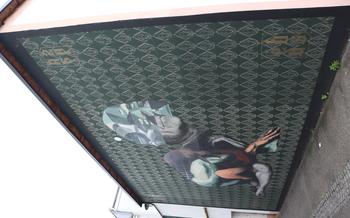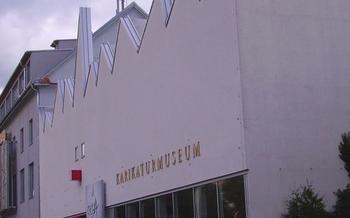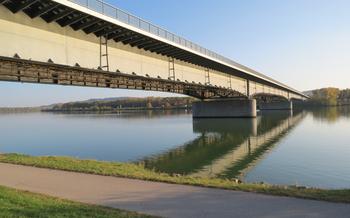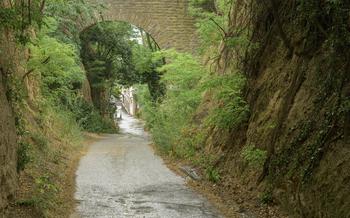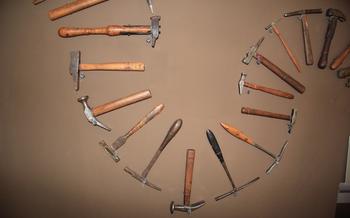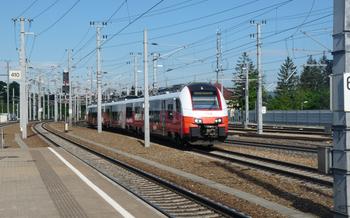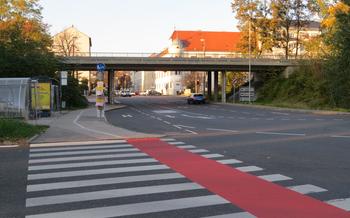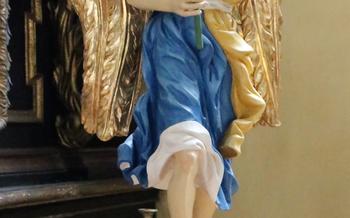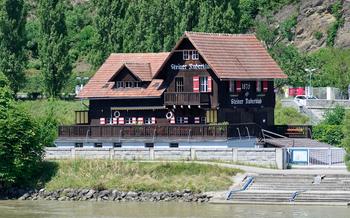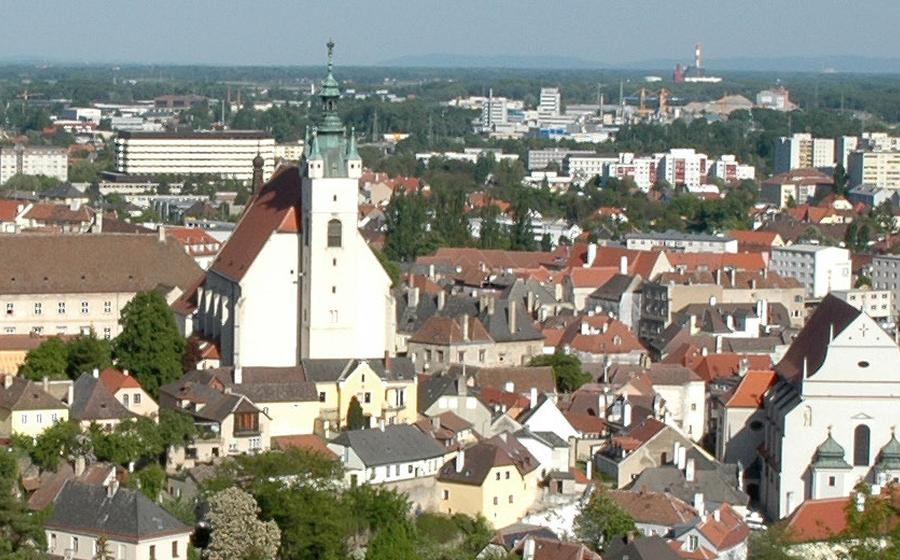
Schallaburg Castle
- History of Schallaburg Castle
- Architectural Features
- Current Use of the Castle
- Museum Collections
- Thematic Exhibitions
- Educational Programs
- Guided Tours
- Accessibility
- Visitor Information
- Getting to Schallaburg Castle
- Where to Stay
- Where to Eat
- Things to Do in the Area
- Insider Tip:
History of Schallaburg Castle
Originating in the 12th century as a modest fortress guarding a strategic Danube River crossing, Schallaburg Castle underwent a remarkable transformation in the 16th century when it was acquired by the noble family of Losenstein. Inspired by the Renaissance ideals of art and architecture, they commissioned the reconstruction of the castle into a magnificent palace. The result was a stunning fusion of medieval grandeur and Renaissance elegance, creating a unique architectural masterpiece in the heart of Austria.
Throughout its history, Schallaburg Castle has been home to several notable noble families, each leaving their mark on its rich tapestry. The Khevenhüllers, who acquired the castle in the 17th century, were instrumental in expanding its art collection and establishing it as a cultural center. The Daun-Kinsky family, who became its owners in the 19th century, further enriched the castle's legacy by hosting lavish parties and events that attracted high society from across Europe.
Among the many legends associated with Schallaburg Castle, the most captivating is the tale of the "White Lady." Believed to be the ghost of a young woman who lost her love during the Thirty Years' War, her apparition is said to wander the castle's corridors, lamenting her tragic fate. Visitors often recount eerie encounters with the White Lady, adding an air of mystery and intrigue to the castle's already enchanting atmosphere.
In the annals of history, Schallaburg Castle played a pivotal role during the Napoleonic Wars. In 1809, it served as the headquarters of Archduke Charles, the Austrian commander-in-chief, as he prepared his forces to confront Napoleon's advancing army. The castle's strategic location and sturdy fortifications made it an ideal base for the Austrian military, contributing to their eventual victory over Napoleon at the Battle of Aspern-Essling.
Architectural Features
Schallaburg Castle stands as a testament to the grandeur of the Renaissance architectural style. Its striking facade is adorned with intricate carvings, decorative elements, and symmetrical proportions that reflect the artistic sensibilities of the period. The castle's exterior showcases a harmonious blend of Gothic and Renaissance influences, creating a unique architectural masterpiece.
One of the most captivating features of the castle is its elaborate Renaissance-style courtyard. Surrounded by graceful arcades and adorned with elegant columns, the courtyard serves as a stunning centerpiece. The intricate details of the arches, cornices, and pilasters add depth and visual interest to the space, creating a sense of grandeur and sophistication.
The castle's towers, with their imposing height and commanding presence, are another notable architectural element. These towers not only provided a strategic advantage for defense but also contributed to the castle's overall aesthetic. The interplay of different rooflines, turrets, and spires creates a dynamic silhouette that is both visually appealing and symbolic of the castle's rich history.
Anecdote: Visitors are often drawn to the unique corner tower of Schallaburg Castle. This tower features an unusual spiral staircase that winds its way up to the top, offering breathtaking panoramic views of the surrounding countryside. The climb may be challenging, but the reward is well worth the effort, as visitors are treated to a stunning visual feast that showcases the beauty of the castle and its surroundings.
Current Use of the Castle
In the 20th century, Schallaburg Castle underwent a remarkable transformation, evolving from a private residence to a vibrant cultural center. In 1974, the castle was acquired by the State of Lower Austria, which recognized its immense cultural significance and potential. Extensive renovations were undertaken to restore the castle to its former glory, preserving its architectural integrity while adapting it to its new role as a cultural hub.
Today, Schallaburg Castle stands as a prominent venue for art, history, and cultural exchange. It hosts a diverse range of exhibitions, showcasing both permanent collections and temporary thematic displays. These exhibitions explore a wide spectrum of topics, from historical events and artistic movements to contemporary social and cultural issues.
The castle's transformation into a cultural center has not only revitalized the castle itself but has also contributed to the cultural landscape of the region. Schallaburg Castle has become a magnet for art enthusiasts, history buffs, and culture seekers, attracting visitors from around the world.
Anecdote:
One memorable exhibition that took place at Schallaburg Castle was the "Renaissance Splendor: Treasures from the Habsburg Court" exhibition in 201This grand exhibition showcased over 300 exquisite artifacts from the Habsburg dynasty, offering visitors a glimpse into the lavish lifestyle and artistic patronage of one of Europe's most powerful royal families. The exhibition was a resounding success, attracting over 200,000 visitors and receiving critical acclaim for its curatorial excellence and immersive presentation.
Museum Collections
Schallaburg Castle is home to a diverse range of museum collections that offer visitors a glimpse into various historical periods and cultural traditions. The Austrian Folk Art Collection showcases a vast array of traditional costumes, textiles, and handicrafts from all regions of Austria, providing insights into the country's rich cultural heritage. The Gothic Art Collection features a stunning array of sculptures, paintings, and stained glass windows, demonstrating the artistic achievements of the medieval period.
The castle's Renaissance and Baroque Art Collection houses a remarkable collection of paintings, sculptures, and decorative arts from the 16th to the 18th centuries, showcasing the opulence and grandeur of these artistic movements. Visitors can admire works by renowned artists such as Lucas Cranach the Elder and Hans Holbein the Younger.
Of particular note is the Schallaburg Tapestry Collection, which features a series of intricate tapestries depicting scenes from the Old Testament and Greek mythology. These magnificent tapestries, woven with vibrant colors and exquisite detail, offer a glimpse into the storytelling and artistic traditions of the Renaissance period.
Anecdote: During a visit to the Schallaburg Castle Museum, I was captivated by a small, unassuming artifact displayed in a glass case. It was an intricately carved wooden spoon, dating back to the 17th century. The curator explained that the spoon was not just a utensil but a symbol of love and devotion. It had been carved by a young man as a gift for his beloved, and the intricate carvings depicted scenes from their courtship and wedding. This simple object, with its poignant story, left a lasting impression on me and reminded me of the enduring power of love and craftsmanship.
Thematic Exhibitions
Schallaburg Castle is renowned for its captivating thematic exhibitions that delve into various historical, cultural, and artistic themes. These exhibitions are designed to engage visitors with interactive and immersive experiences, allowing them to explore different periods and subjects in a dynamic and thought-provoking manner.
Past exhibitions have covered a wide range of topics, from the history of the Knights Templar to the art of the Renaissance. Each exhibition is carefully curated to present a comprehensive and engaging narrative, incorporating a variety of artifacts, artworks, and multimedia displays.
One particularly memorable exhibition focused on the life and times of Empress Maria Theresa, one of the most influential rulers in Austrian history. The exhibition showcased her personal belongings, including her elaborate gowns and jewelry, as well as documents and portraits that shed light on her reign and the social and political landscape of the 18th century.
Visitors were able to immerse themselves in the world of Maria Theresa through interactive displays and hands-on activities. They could try on replica costumes, write with quill pens, and even sample some of the culinary delights enjoyed by the empress and her court.
These thematic exhibitions not only provide a glimpse into the past but also encourage visitors to think critically about history and culture. They offer a unique opportunity to learn, engage, and be inspired by the stories and artifacts that have shaped the world we live in.
Educational Programs
Schallaburg Castle is not just a museum but also a vibrant center for education and cultural engagement. It offers a diverse range of educational programs designed to inspire and educate visitors of all ages. These programs are tailored to different age groups and interests, ensuring that everyone can find something to learn and enjoy.
One of the highlights of the educational offerings is the castle's workshop program. These hands-on workshops provide participants with a unique opportunity to immerse themselves in history and culture through interactive activities. From medieval crafts to Renaissance art, there's something for everyone to explore and create.
Guided tours are another excellent way to delve into the castle's rich history and architecture. Knowledgeable guides lead visitors through the castle's grand halls and chambers, sharing fascinating stories and insights about the people who lived and worked here. The tours are available in multiple languages, making the castle accessible to visitors from all over the world.
For those seeking a more in-depth learning experience, the castle offers thematic seminars and lectures. These events bring together experts and scholars to discuss various historical, cultural, and artistic topics related to the castle and its collections. Attendees can engage in thought-provoking discussions and gain a deeper understanding of the castle's significance.
Anecdote:
During a recent visit to Schallaburg Castle, I had the pleasure of participating in a workshop on medieval calligraphy. Under the guidance of a skilled calligrapher, I learned the art of creating beautiful letters and flourishes using a quill pen and ink. It was a fascinating and rewarding experience that allowed me to connect with the past in a tangible way. The workshop not only taught me a new skill but also gave me a greater appreciation for the artistry and craftsmanship of medieval scribes.
Guided Tours
Schallaburg Castle offers guided tours in a variety of languages, allowing visitors to delve deeper into its rich history and cultural significance. Led by knowledgeable and passionate guides, these tours provide an immersive experience that brings the castle's stories to life. Visitors can choose from general tours that cover the castle's highlights, or opt for themed tours that explore specific aspects of its history, architecture, or collections. Private tours can also be arranged for a more personalized experience.
One unforgettable anecdote from a guided tour centers around the legend of the "White Lady" of Schallaburg. The guide recounted the tale of a tragic love story that unfolded within the castle walls, leaving behind a ghostly presence that is said to haunt the halls. Visitors were captivated by the eerie atmosphere and the guide's vivid storytelling, creating a lasting memory of their visit to Schallaburg Castle.
Accessibility
Schallaburg Castle is committed to ensuring that all visitors, regardless of their abilities, can enjoy and explore the castle and its offerings. Accessibility features have been carefully considered and implemented to make the castle as welcoming and inclusive as possible.
Wheelchair access is available throughout the castle, with ramps and elevators providing easy movement between floors. Specially designed restrooms have been installed for the convenience of visitors with disabilities. The castle also provides wheelchairs for visitors who may need them, ensuring that everyone can participate in guided tours and explore the museum collections.
The staff at Schallaburg Castle is trained to be attentive and supportive to visitors with disabilities. They are always willing to assist with any special requests or requirements, ensuring that every visitor has a positive and memorable experience.
Anecdote:
During a visit to Schallaburg Castle, I witnessed the exceptional care and attention given to a visitor with a disability. The staff went above and beyond to ensure that the visitor had a comfortable and enjoyable experience. They provided a wheelchair, arranged for a personal tour guide who could accommodate the visitor's needs, and even helped to carry the visitor's belongings. The visitor expressed their gratitude, saying that they had never felt so welcome and supported at a historical site.
Visitor Information
When planning your visit to Schallaburg Castle, it's essential to consider the practicalities. The castle is open to the public from March to November, with varying hours depending on the season. Check the official website for the most up-to-date information on opening hours and admission fees. Guided tours are available in multiple languages and offer a deeper insight into the castle's history and significance.
For those looking to save, consider taking advantage of the reduced rates for students, seniors, and families. The castle also offers special discounts for groups and online bookings. If you're traveling on a budget, pack a lunch and enjoy a picnic in the picturesque castle grounds.
To make your visit as smooth as possible, check the website for any upcoming events or special exhibitions that might interest you. You can also book your tickets online to avoid queues, especially during peak season. Don't forget to bring comfortable shoes as you'll likely do a lot of walking around the castle and its surroundings.
Anecdote:
During my visit to Schallaburg Castle, I had a memorable interaction with a friendly and knowledgeable member of the visitor service team. She went above and beyond to ensure I had a great experience. She provided me with a map of the castle, highlighting areas of particular interest, and even suggested a few hidden gems that I might have missed otherwise. Her enthusiasm and passion for the castle's history were truly infectious, making my visit all the more enjoyable.
Getting to Schallaburg Castle
Reaching Schallaburg Castle is a breeze, with multiple transportation options available to suit every traveler's preference. For those arriving by train, the nearest station is Krems an der Donau, a mere 5 kilometers from the castle. From there, a short bus ride or a pleasant walk along the scenic Danube River will lead you to the castle's gates.
If you're traveling by car, the journey is equally convenient. Simply follow the signs to Schallaburg Castle, and you'll find ample parking spaces available on-site. The castle's strategic location makes it easily accessible from major highways, ensuring a smooth and stress-free drive.
For those seeking a more immersive experience, consider embarking on a scenic bike ride through the picturesque Wachau Valley. The well-maintained bike paths offer breathtaking views of the vineyards, orchards, and charming villages that dot the landscape. Upon reaching Schallaburg Castle, you can securely lock your bike at the designated parking area and explore the castle's wonders on foot.
No matter your chosen mode of transportation, the journey to Schallaburg Castle is an experience in itself, offering a taste of the region's natural beauty and historical charm. Embrace the adventure, soak in the scenery, and let the excitement build as you approach this magnificent Renaissance masterpiece.
Where to Stay
Krems an der Donau offers a variety of accommodation options for visitors seeking a comfortable and convenient stay near Schallaburg Castle.
-
Hotels: For a luxurious and pampering experience, visitors can choose from several upscale hotels in Krems. These hotels offer elegant rooms, modern amenities, and often stunning views of the Danube River.
-
Guesthouses: For those seeking a more intimate and authentic experience, guesthouses provide a charming alternative to hotels. These family-run establishments offer cozy rooms, traditional Austrian hospitality, and the opportunity to interact with local residents.
-
Apartments: For travelers seeking more independence and flexibility, self-catering apartments are an excellent option. These apartments offer fully equipped kitchens, spacious living areas, and the convenience of being able to prepare meals at your own leisure.
No matter your budget or preferences, you're sure to find the perfect accommodation in Krems an der Donau to complement your visit to Schallaburg Castle.
Anecdote:
During my stay in Krems, I had the pleasure of residing at a charming guesthouse called "Zum Goldenen Hirsch." The guesthouse was located just a short walk from Schallaburg Castle, offering breathtaking views of the castle from my room. The hosts were incredibly welcoming and provided me with insider tips on the best things to see and do in the area. The traditional Austrian breakfast served each morning was a delightful way to start my day of exploration.
Where to Eat
Authentic Austrian Cuisine in Krems an der Donau
After exploring the wonders of Schallaburg Castle, indulge in a culinary journey that showcases the rich flavors of traditional Austrian cuisine. Krems an der Donau is home to a diverse range of restaurants and cafes that offer a delightful blend of local specialties and international favorites.
For a truly authentic Austrian experience, visit one of the many traditional taverns, known as "Gasthäuser," that line the streets of the old town. Here, you can savor hearty dishes such as Wiener Schnitzel, Tafelspitz (boiled beef), and Käsespätzle (cheese spaetzle). Pair your meal with a glass of Austrian wine, renowned for its crisp and fruity flavors.
If you prefer a more modern dining experience, Krems offers a range of contemporary restaurants that reinterpret classic Austrian dishes with a creative twist. Experiment with innovative fusion flavors or opt for lighter and healthier options that showcase the region's fresh produce.
Vegetarians and vegans can rejoice, as Krems offers several restaurants that cater to their dietary needs. From colorful salads and hearty soups to inventive plant-based dishes, there's something to satisfy every palate.
No matter your preference, Krems an der Donau offers a culinary adventure that will leave your taste buds dancing. Immerse yourself in the flavors of Austria and enjoy a memorable dining experience that complements your visit to Schallaburg Castle.
Anecdote:
During my stay in Krems, I stumbled upon a hidden gem tucked away in a quiet corner of the old town. The unassuming facade of "Zum Goldenen Hirschen" concealed a culinary treasure trove that delighted my senses. The atmosphere was warm and inviting, with friendly staff who seemed genuinely passionate about their craft. I opted for the Tafelspitz, a classic Austrian dish of boiled beef served with horseradish sauce and apple compote. The meat was melt-in-your-mouth tender, and the flavors were simply exquisite. Paired with a glass of local Grüner Veltliner wine, the meal was an absolute triumph. As I savored each bite, I couldn't help but feel grateful for the unexpected culinary discovery that made my visit to Krems an der Donau truly unforgettable.
Things to Do in the Area
Beyond the captivating allure of Schallaburg Castle, the surrounding region beckons with a wealth of attractions and activities that promise unforgettable experiences. History buffs can delve into the rich past of Krems an der Donau, a picturesque town brimming with medieval charm. Its cobbled streets, adorned with pastel-hued buildings, lead to historic landmarks like the Steiner Tor, a 13th-century gate tower, and the Gozzoburg, a former castle transformed into a museum showcasing local history and culture.
Nature enthusiasts will find solace in the idyllic landscapes that envelop Krems an der Donau. The gentle hills of the Wachau Valley, a UNESCO World Heritage Site, offer a haven for hiking and biking amidst vineyards, orchards, and charming villages. The Danube River, a majestic waterway that meanders through the region, invites visitors to embark on scenic boat cruises, offering panoramic views of the valley's natural splendor.
For a taste of local traditions, visitors can explore the surrounding villages, each with its own unique character and charm. Spitz, with its distinctive blue church steeple, offers a glimpse into the region's winemaking heritage. Dürnstein, nestled amidst vineyards, boasts a captivating history linked to the imprisonment of Richard the Lionheart.
Outdoor enthusiasts will delight in the numerous hiking and biking trails that crisscross the region, providing opportunities to immerse themselves in the beauty of nature. The Kamp Valley, with its rugged cliffs and lush forests, offers challenging trails for experienced hikers, while the family-friendly Donauradweg (Danube Cycle Path) winds along the river, offering a leisurely way to explore the region's scenic landscapes.
No matter what your interests, the area surrounding Schallaburg Castle promises a multitude of experiences that will enrich your journey through the heart of Austria.
Insider Tip:
For those seeking a unique experience, venture beyond the castle's walls and discover the picturesque town of Krems an der Donau. Stroll along the charming cobblestone streets, admire the colorful facades of historic buildings, and soak in the vibrant atmosphere. Don't miss the chance to sample local delicacies at one of the many traditional restaurants or cafes, where you can indulge in mouthwatering Austrian cuisine and regional specialties. The town also hosts regular events and festivals throughout the year, offering a glimpse into the rich cultural heritage of the region. Whether you're a history buff, a nature enthusiast, or simply seeking a relaxing getaway, Krems an der Donau has something to offer everyone.
